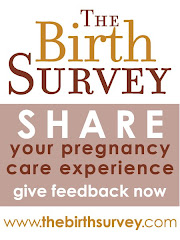Domestic violence was the first social justice cause in my life that I became deeply committed to. Though I haven't worked in battered women's shelters in quite a few years now, and the focus in my life has become birth activism, I still care a great deal about family violence prevention--which, obviously, is tied strongly into why I care so much about healthy, respectful, humane births for women and babies! Violence against women is a public health issue.
Three women each day in the U.S. are murdered by their husbands or boyfriends and 500 women each day are raped or sexually assaulted. Knowing this, I can't help but wonder why the AMA finds it worthwhile to target homebirth and issue a resolution against homebirth. It seems more logical to issue a "resolution against marriage" or "a resolution against having a boyfriend."
In the fall 2007 issue of CfM News, Susan Hodges had a sidebar in my article (Domestic Violence During Pregnancy) about violence against women in medical settings. Given that October is domestic violence awareness month, I wanted to share a quote from her sidebar:
"While the situation is different from domestic violence in some ways, it is also similar. Abuse in the medical setting is also about power and control, the pregnant or laboring woman is often blamed for her situation, and verbal and emotional abuse can be similar. Because we are taught to “trust your doctor”, and in fact there is an explicit assumption of trust in the “fiduciary relationship” between the woman and her doctor who is an “expert”, most of us do not think about the possibility of abuse, and many of us stay with the OB or feel we have no choice about our health care providers or settings, especially when we are in labor. Also, the doctors and staff generally are not even aware that their behavior or actions are abusive."
I get an informative e-newsletter called Speaking Up from the Family Violence Prevention Fund (On a related side note, when their supplies are in stock, this organization also provides free due-date calculator wheels that are printed with domestic violence screening questions as a reminder to maternity care providers to ask their clients about DV). I wanted to share some information from this last newsletter:
"October is Domestic Violence Awareness Month (DVAM) and across the country, advocates are joining health care providers, business leaders, policy makers, faith-based groups, college students and others at events and activities designed to educate the public about domestic and sexual violence. Events include national campaigns, statewide activities and community events."
"The Centers for Disease Control and Prevention reports 1,200 deaths and two million injuries to women from intimate partner violence each year.
• According to the U.S. Bureau of Justice Statistics, on average three women a day are murdered by their husbands or boyfriends in the United States. Women are 84 percent of spouse abuse victims, 86 percent of victims of abuse at the hands of a boyfriend or girlfriend, and three in four victims of family violence.
• Almost 500 (483) women are raped or sexually assaulted each day, on average, in the United States. [U.S. Bureau of Justice Statistics]"






